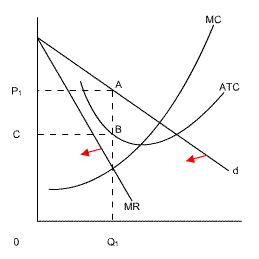- CFA Exams
- 2026 Level I
- Topic 2. Economics
- Learning Module 1. The Firm and Market Structures
- Subject 7. Monopolistic Competition
Why should I choose AnalystNotes?
AnalystNotes specializes in helping candidates pass. Period.
Subject 7. Monopolistic Competition PDF Download
A monopolistic market is also called a competitive price searcher market.
Characteristics are:
A large number of firms. This is due to low entry barriers and causes intense competition in these markets. Firms face competition from existing firms and potential entrants to the market.
Firms produce differentiated products. This means that each firm makes a product that is slightly different from the products of competing firms. This is the most distinctive characteristic of such a market.
Low entry barriers. Entry into and exit from the market are relatively easy. Sellers in competitive price searcher markets face competition both from firms already producing in the market and from potential new entrants into the market. If profits are present, firms can expect that new rivals will be attracted. Because of the low entry barriers, competitive forces will be strong in monopolistic markets, and firms cannot earn an economic profit in the long run.
Competition on quality, price, and marketing. Demand is not simply given for a monopolistic competitor. The firm has some pricing power and can alter the demand for its products by changing product quality (design, reliability and service), location and by advertising. The firm faces a downward-sloping demand curve. This demand curve is highly elastic because good substitutes for a firm's output are readily available from other suppliers.
Consider two hamburger companies: McDonald's and Burger King.
- Both firms are producing burgers but customers view them as differentiated.
- If McDonald's increases the price of its burger, it will not lose all its customers, as some will continue to pay the higher price, preferring McDonald's.
- Thus, differentiation explains the downward-sloping demand curve. The more firms producing burgers (substitutes), the more elastic McDonald's demand curve will be, since the greater the decrease in quantity demanded as price increases.
The Firm's Short-Run Output and Price Decision
As with price takers, monopolistic competitors maximize profits by expanding output to where MR = MC.
A firm in monopolistic competition operates much like a single-price monopolist.

According to the demand curve, the firm can charge P1 per unit.
- The total revenue earned is the shaded area 0P1AQ1.
- The total cost is the shaded area 0CBQ1.
- It earns an economic profit (as in this example) when P > ATC. The total profit is thus the difference between total revenue and total costs, and is given by the shaded area CP1AB.
A firm might incur an economic loss in the short run when P < ATC.
Long Run: Zero Economic Profit
Whenever firms can freely enter and exit a market, profits and losses play an important role in determining the size of the industry. Economic profits will attract new competitors to the market and economic losses will cause competitors to exit from the market. In the short run, a price searcher may make either economic profits or losses, depending on market conditions. As firms enter the industry, each existing firm loses some of its market share. The demand for its product decreases and the demand curve for its product shifts leftward.

The decrease in demand decreases the quantity at which MR = MC and lowers the maximum price that the firm can charge to sell this quantity. After long-run adjustments have been made, price and quantity fall with firm entry until P = ATC and firms earn zero economic profit.
If firms incur an economic loss, firms exit, to achieve long-run equilibrium.
User Contributed Comments 3
| User | Comment |
|---|---|
| hwh1313 | Why is price (on the vertical axis) not at the point where Q1 hits the MR curve, but is instead at the point where Q1 hits the D curve? isn't the marginal revenue from the last unit sold equal to its price? Thx. |
| choas69 | @ hwh1313 dont confuse between perfectly competitive market and monopolistic market; 1- what you're referring to is a situation in perfectly competitive market because firms are price takers they can only sell at the price market thus MR = P a perfectly horizontal demand curve. and increase output to maximize profit. 2- however in this situation the demand curve is downward sloping because they are price searches as the example given above between mcdonald and burgerking and to maximize profit the firms output should be where MR = MC. NOTE: MR=MC is not the only way to maximize profit. refer to reading 14 for more. |
| Huricane74 | @hwh1313 One key point to remember is that in a perfectly competitive market, the products are identical or almost identical. Think of items on the commodities exchange such as steel, oil and pork bellies which are traded on the basis of only price. This is why the demand curve is horizontal and suppliers /firms are price takers. In a monopolistic market, firms offer similar but distinct products. Only McDonald's sells the Big Mac and only Burger King sells the Whopper. Thus McDonald's has the monopoly on the Big Mac and the Burger King has the monopoly on the Whopper. This allows firms to offer products based on differences in quality, features and service. Thus, firms are not price takers as they are able to create demand for their specific product. |

I was very pleased with your notes and question bank. I especially like the mock exams because it helped to pull everything together.

Martin Rockenfeldt
My Own Flashcard
No flashcard found. Add a private flashcard for the subject.
Add